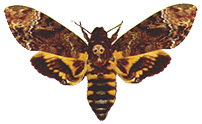|
Acherontia lachesis Fabricius
Sphinx lachesis Fabricius, 1798, Ent. Syst., Suppl. p. 434.
Acherontia lachesis Fabricius; Rothschild & Jordan, 1903: 17.
|

Acherontia lachesis ♀
(.65 natural size)
|
Diagnosis. This and the next species both have skull-like markings on the
thorax, a yellow ground colour to the hindwing and blue patches dorsally
on each segment
of the abdomen. A. lachesis is distinguished by a more variegated
forewing, broader dark brown bands on the hindwing, including a diagnostic
basal patch, broader dark rings to the abdomen between which the blue
patches are much broader.
Geographical range. Oriental Region to S. Moluccas.
Habitat preference. This species is often common and is generally
distributed as an adult. It may hill-top, being taken at high altitudes on
both G. Kinabalu and G. Mulu.
Biology. Dupont & Roepke (1941) noted the Javan larvae to vary in
colour: yellow, green or greyish brown. They suggested this might in part
be dependent on the food-plant. Bell & Scott (1937) illustrated the
green and brown forms from India: the oblique stripes on the green form
are blue above, yellow below, each colour intensifying towards the sharp
central division; in the brown form the stripes are much fainter, pale
brown and dull bluish grey, and the thoracic segments are broadly dark
dorsally, pale subdorsally and medium brown laterally.
Recorded host-plants (Bell & Scott, 1937; Dupont & Roepke, 1941;
Browne, 1968; Pholboon, 1967; Yunus & Ho (1980); Miyata, 1983); are:
Barleria, Sanchezia (Acanthaceae, latter introd.); Catalpa, Spathodea,
Stereospermum, Tecoma (Bignoniaceae); Cannabis (Cannabinidaceae);
Canna (Cannaceae);
Helianthus (Compositae) Ipomoea, Merremia (Convolvulaceae);
Luffa (Cucurbitaceae);
Ehretia (Ehretiaceae); Antidesma (Euphorbiaceae); Anisomeles,
Colebrookia,
Coleus, Pogostemon (Labiatae); Cajanus, Cassia, Centrosema, Clitorea,
Dolichos, Erythrina, Glycine, Psophocarpus, Vigna (Leguminosae); Melia
(Meliacae);
Jasminum, Nyctanthes (Oleaceae); Sesamum (Pedaliaceae); Paulownia
(Scrophulariaceae);
Cyphomandra, Datura, Lycopersicum, Nicotiana, Solanum (Solanaceae);
Callicarpa, Clerodendrum, Lantana, Stachytarpheta, Tectona, Vitex (Verbenacceae);
Nicolaia (Zingiberaceae).
<<Back
>>Forward <<Return
to Contents page
|

